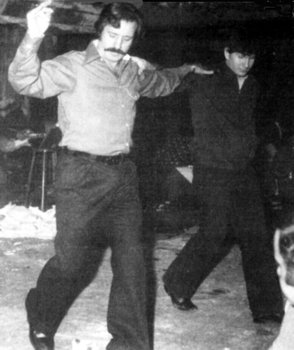
|
Folk Dance Federation of California, South, Inc.
|

|
CLICK IMAGE TO ENLARGE
Most people visiting Greece expect to find the Greeks dancing in the streets or spontaneously breaking out into an ecstatic wild Greek dance like Zorba. Unfortunately, the people will dance only at a specific occasion, at a feast, a holiday to celebrate an important family event such as a weeding, baptism, etcetera. For many years, even in the villages, dancing was restricted only to such noteworthy events that brought everyone out, and celebrated their movement with all their friends, relatives, and neighbors.
The exchanges, loud and clear, recorded many significant feelings among the celebrants. In recent years the taverna, an outgrowth of the coffeehouses, which were originally restricted to men, began to introduce music and musicians, who would crowd in an play longing melodies to raise a few drachmas. For a number of years, these tavernas were also somewhat restricted to families, as the men who alone dominated the scene with wine drinking and their soulful solo dances extracted from their pathos of daily routine suffering that they endured. The bouzouki [a long-necked Greek lute] had been condemned by the staple Greek society as being an instrument of the downbeat and the underground, the instrument of the dens of iniquity, and all those lowbrows who sought inferior expressions.
But time, like all factors, changed these facts, and soon the bouzouki was gaining popularity and became the lord of all Greek instruments. It was now fashionable, by family and good-standing Greek citizens, to visit these tavernas where the bouzouki reigned. Participating in these excited passions were becoming the fashionable thing to be done by all. "Going to Bouzoukia," as the Greeks tend to refer to it, when visiting Greece, is a must, a night out which you will remember for a long time.
Today, it is what to do at the bouzoukia: at first they ate, they drank, then they just ate, or in some places they just drank, but they always listened to the music. Lead singers, and the most popular singers, joined the rage of bouzouki music with new compositions, and soon the café society of Greece was being regaled by the appearance of the most outstanding musicians, composers, singers, and "top notch" bouzouki players.
The Crowds with the gaining momentum of their emotions and feelings that needed expression, and the economics of these clubs to sustain growing tariffs as the weekly bills mounted, for the Greeks are not heavy drinkers, began to break dishes, throw baskets of flowers and colorful beads at their favorite singer or bouzouki player or express their appreciation and release pent-up feelings.
Folklore now visits the local taverna, and the social dance is one of their native doings, as opposed to before World War II, when they were still imitating waltzes, tangos, rumbas, and cha-chas. Now it is the hasapiko, syrto, zeimbekiko, karsilamas, and tsiftetelli that bring this age of Greeks to reach a high by destroying dishes, a symbol of matter that he breaks in order to free himself from being enslaved by material things. This is the sense of rejecting psychologically that which they are subjected to in everyday life, thus they are constantly striving for more money, to buy material things. It is this kind of irrationality that still exists in the Greek character, that which makes life plausible in that land that is difficult, barren, and goals are monumental, but where despite the rational of setting things straight, and setting goals of achievement, they need to have that moment when doing their thing brings them back to a peculiar sanity with a harmless act of insanity. Thus, the pile of dishes that you see in the photo, while dancing madly one night in a taverna, and by dancing it seems to take on a different dimension at times.
Athan Karras with his associate Steve Reynolds,
who visited a Taverna in Athens in 1983.
Note the broken dishes in the back.
Photo by Kypros, Athens.
Reprinted from "Dancing in Greece" by Athan Karras.
Viltis Magazine, December 1983, Volume 42, Number 4, V. F. Beliajus, Editor.
